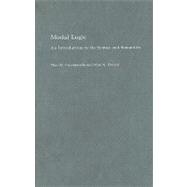
| Introduction | p. 1 |
| The Metalanguage | p. 1 |
| Logical Syntax | p. 4 |
| Symbols and Expressions | p. 4 |
| Concatenation | p. 5 |
| Formal Languages and Systems | p. 6 |
| The Logistic Method | p. 8 |
| Tautologous Implication | p. 13 |
| The Syntax of Modal Sentential Calculi | p. 15 |
| Sentential Modal Logic | p. 15 |
| Modal CN-Formulas | p. 16 |
| Modal-Free and Modally-Closed Formulas | p. 17 |
| Modal CN-Calculi | p. 18 |
| Classical Modal Calculi | p. 19 |
| Regular and Normal Modal Calculi | p. 20 |
| The MP Rule | p. 22 |
| The Systems [Sigma subscript K] | p. 23 |
| Some Standard Normal Modal CN-Calculi | p. 27 |
| The Modal System Kr | p. 28 |
| The Modal System M | p. 30 |
| The Modal System Br | p. 31 |
| The Modal System S4 | p. 33 |
| The Modal System S4.2 | p. 34 |
| The Modal System S4.3 | p. 34 |
| The Modal System S5 | p. 36 |
| The Systems S1, S2, and S3 | p. 37 |
| Modalities | p. 42 |
| Matrix Semantics | p. 45 |
| CN-Matrices | p. 46 |
| The Standard Two-Valued CN-Matrix | p. 48 |
| Modal CN-Matrices | p. 52 |
| Henle Modal CN-Matrices | p. 55 |
| Semantics for Logical Necessity | p. 61 |
| The Problem of a Semantics for Logical Necessity | p. 62 |
| Carnap's Adequacy Criterion | p. 64 |
| Logical Atomism and Modal Logic | p. 66 |
| Semantics for S5 | p. 71 |
| All Possible Worlds "Cut Down" | p. 71 |
| Matrix Semantics for S5 | p. 75 |
| Decidability of L[subscript at] and S5 | p. 78 |
| Relational World Systems | p. 81 |
| Relational World Systems Defined | p. 81 |
| The Class of All Relational World Systems | p. 89 |
| Reflexivity and Accessibility | p. 92 |
| Transitive World Systems | p. 96 |
| Quasi-Ordered World Systems | p. 98 |
| Symmetric World Systems | p. 100 |
| Reflexive and Symmetric World Systems | p. 101 |
| Transitive and Symmetric World Systems | p. 102 |
| Partitioned World Systems | p. 103 |
| Connexity and Accessibility | p. 107 |
| Connectable Accessibility | p. 113 |
| Quantified Modal Logic | p. 119 |
| Logical Syntax | p. 120 |
| First-Order Languages | p. 122 |
| Proper Substitution | p. 124 |
| Quantified Modal CN-Calculi | p. 128 |
| Quantified Extensions of Kr | p. 140 |
| Omega-Completeness in Modal Logic | p. 147 |
| The Semantics of Quantified Modal Logic | p. 153 |
| Semantics of Standard Modal-Free Formulas | p. 154 |
| The Semantics of Logical Necessity | p. 158 |
| The Thesis of Anti-Essentialism | p. 159 |
| Incompleteness of the Primary Semantics | p. 162 |
| Secondary Semantics for Necessity | p. 164 |
| Actualist-Possibilist Secondary Semantics | p. 169 |
| Relational Model Structures | p. 177 |
| Second-Order Modal Logic | p. 183 |
| Second-Order Logical Syntax | p. 184 |
| Second-Order Languages | p. 185 |
| Proper Substitution | p. 188 |
| Second-Order CN-Modal Calculi | p. 192 |
| Second-Order Extensions of Kr | p. 202 |
| Second-Order Omega-Completeness | p. 209 |
| Semantics of Second-Order Modal Logic | p. 215 |
| Semantics of Modal-Free Second-Order Formulas | p. 216 |
| General Models | p. 221 |
| Semantics of Standard Second-Order Modal Languages | p. 224 |
| Actualist-Possibilist Second-Order Semantics | p. 231 |
| Second-Order Relational World Systems | p. 243 |
| Afterword | p. 253 |
| Bibliography | p. 257 |
| Index | p. 263 |
| Table of Contents provided by Ingram. All Rights Reserved. |
The New copy of this book will include any supplemental materials advertised. Please check the title of the book to determine if it should include any access cards, study guides, lab manuals, CDs, etc.
The Used, Rental and eBook copies of this book are not guaranteed to include any supplemental materials. Typically, only the book itself is included. This is true even if the title states it includes any access cards, study guides, lab manuals, CDs, etc.